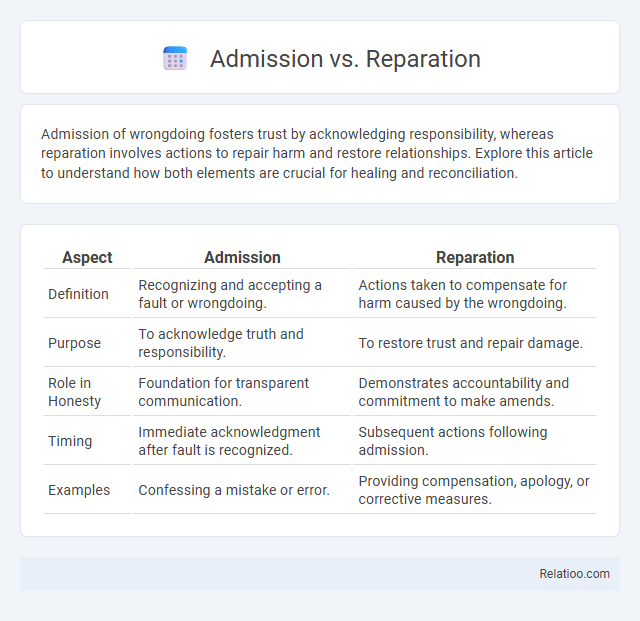Admission of wrongdoing fosters trust by acknowledging responsibility, whereas reparation involves actions to repair harm and restore relationships. Explore this article to understand how both elements are crucial for healing and reconciliation.
Table of Comparison
| Aspect | Admission | Reparation |
|---|---|---|
| Definition | Recognizing and accepting a fault or wrongdoing. | Actions taken to compensate for harm caused by the wrongdoing. |
| Purpose | To acknowledge truth and responsibility. | To restore trust and repair damage. |
| Role in Honesty | Foundation for transparent communication. | Demonstrates accountability and commitment to make amends. |
| Timing | Immediate acknowledgment after fault is recognized. | Subsequent actions following admission. |
| Examples | Confessing a mistake or error. | Providing compensation, apology, or corrective measures. |
Introduction: Understanding Admission and Reparation
Admission refers to acknowledging responsibility or fault for an act, often serving as a prerequisite for reparations. Reparation involves compensatory actions or restitutions made to address harm caused by wrongful conduct. Understanding the distinction between admission and reparation is crucial for effectively resolving disputes and achieving justice.
Defining Admission in Legal and Social Contexts
Admission in legal contexts refers to a party acknowledging facts or liability within judicial proceedings, serving as evidence that can influence case outcomes. Socially, admission involves openly accepting responsibility or wrongdoing, fostering accountability and trust within relationships or communities. Unlike reparation, which focuses on compensating for harm caused, admission is about the acknowledgment that precedes any corrective action.
Reparation: Meaning and Historical Background
Reparation refers to the act of making amends for a wrong or injury, especially through compensation or restitution to victims or their descendants. Historically, reparations have been addressed in contexts such as post-war settlements, slavery abolition, and colonial injustices, aiming to acknowledge and rectify systemic harms. Understanding reparation enables you to appreciate its role in promoting justice and healing historical grievances.
Key Differences Between Admission and Reparation
Admission involves acknowledging a fault or mistake, typically by an individual or organization, while reparation refers to the actions taken to make amends or compensate for the harm caused. The key difference lies in admission being a verbal or written acknowledgment without necessarily providing compensation, whereas reparation includes tangible measures such as financial restitution, apologies, or rehabilitation programs. Admission often serves as the first step towards reparation, fostering accountability and enabling the affected parties to seek justice or remedy.
Importance of Admission in Conflict Resolution
Admission plays a critical role in conflict resolution by acknowledging responsibility and fostering trust between parties, which is essential for genuine reconciliation. Unlike reparation, which involves compensation or restitution, admission serves as the foundational step that validates the grievances and opens the path for meaningful dialogue. Effective conflict resolution relies on admission to create an environment where parties can collaboratively address harm and work toward sustainable peace.
Role of Reparation in Restorative Justice
Reparation plays a crucial role in restorative justice by addressing the harm caused to victims and fostering healing through tangible or symbolic compensation. Unlike admission, which involves acknowledging wrongdoing, and reparation, focused solely on making amends, reparation in restorative justice emphasizes building trust and restoring relationships within the community. Your active participation in reparation processes can help transform accountability into meaningful recovery and social cohesion.
Admission Without Reparation: Implications and Risks
Admission without reparation can undermine the healing process and exacerbate mistrust among affected parties, leaving victims without tangible acknowledgment or compensation for harm suffered. Failing to provide reparation after admission risks perpetuating injustice, as acknowledgement alone does not address the material or emotional consequences of wrongdoing. Your pursuit of justice should consider that meaningful reparation is essential to complement admission, ensuring accountability and fostering reconciliation.
Effective Reparation Strategies Post-Admission
Effective reparation strategies post-admission prioritize comprehensive measures including financial compensation, public apologies, and restorative justice programs to address harm and rebuild trust. Tailored reparations that integrate community participation and acknowledge victims' experiences enhance healing and promote social cohesion. Monitoring and evaluation mechanisms ensure accountability and the sustained impact of reparation initiatives following admission.
Global Case Studies: Admission and Reparation in Practice
Admission and reparation function as critical components in addressing historical injustices, with global case studies illustrating varied approaches depending on sociopolitical contexts. You can observe that in South Africa's Truth and Reconciliation Commission, admission of past abuses facilitated reparations aimed at healing and restorative justice, while in Canada, the Indian Residential Schools Settlement Agreement paired official acknowledgment with monetary and symbolic reparations. These examples underscore that effective reparations require transparent admission of wrongdoing combined with tailored compensation strategies to achieve meaningful redress.
Conclusion: Integrating Admission and Reparation for True Accountability
Integrating admission and reparation is essential for achieving true accountability in justice processes, as admission acknowledges wrongdoing while reparation addresses the harm caused. You empower victims by validating their experiences and fostering healing through a combination of transparency and tangible remedial actions. Combining these elements strengthens trust, promotes reconciliation, and supports sustainable peacebuilding efforts.

Infographic: Admission vs Reparation
 relatioo.com
relatioo.com